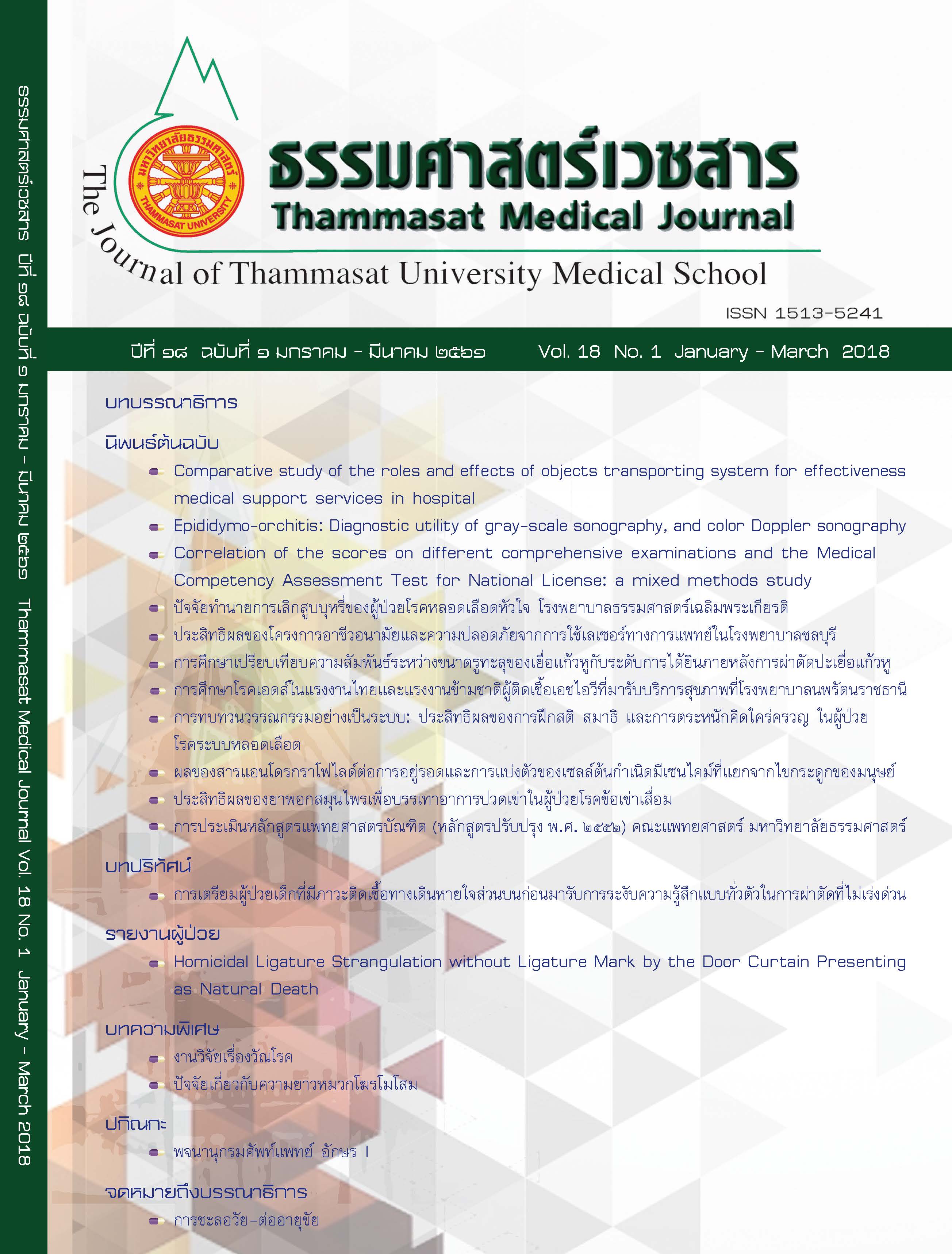A Systematic Review of the Effectiveness of Mindfulness Meditation and Contemplation upon Vascular Disease Patients.
Keywords:
Mindfulness, Meditation, Contemplation, Systematic review, Chronic vascular disease., สติ, สมาธิ, การตระหนักคิดใคร่ครวญ, การทบทวนวรรณกรรมอย่างเป็นระบบ, โรคระบบหลอดเลือดเรื้อรังAbstract
Introduction: The literatures of evidence-based practice of mindfulness meditation and contemplation intervention in patients with chronic vascular disease were studied for principle, design, and outcome.
Method: The keywords, mindfulness, meditation, contemplation, cognitive awareness, vascular disease, using databases Pubmed Central (PMC), ScienceDirect, SpringerLink, Scopus, Wiley Online Library, The Cumulative Index to Nursing and Allied Health Literature (CINAHL) Complete, PsycINFO, and Mosby's Nursing Consult were examined from for January 2005 to November 2015.
Results: Ten articles met inclusion criteria with high quality of methodology. From 20 to 110 patients were samples in the studies conducted in Thailand, the United States of America, Europe, and Africa. Main principles included raising awareness and complete acceptance from inside and outside through bodily awareness, emotions, and selfhood as part of the group reflection process; reducing stress and managing cognition; continuing education at home. In addition, the effectiveness of mindfulness meditation and contemplation showed in psychology and physiology upon vascular disease.
Conclusion and suggestion: These findings pointed to the controlled trial using and health behaviors quantitative and qualitative outcome, which should be further use.
บทคัดย่อ
บทนำ: งานวิจัยนี้มีวัตถุประสงค์เพื่อค้นหาเป้าหมายและหลักวิธีการสำคัญ ของการฝึกสติ สมาธิ และการตระหนักคิดใคร่ครวญ ต่อผู้ป่วยโรคระบบหลอดเลือดเรื้อรัง โดยใช้วิธีการค้นหาหลักฐานเชิงประจักษ์อย่างเป็นระบบ
วิธีการศึกษา: ใช้คำสำคัญ สติ สมาธิ การตระหนักคิดใคร่ครวญ โรคระบบหลอดเลือด ในการสืบค้นข้อมูลงานวิจัยที่ถูกตีพิมพ์ช่วงปี ค.ศ.๒๐๐๕ - ๒๐๑๕ จากฐานข้อมูลอิเล็กโทรนิกส์ Pubmed Central (PMC), ScienceDirect, SpringerLink, Scopus, Wiley Online Library, The Cumulative Index to Nursing and Allied Health Literature (CINAHL) Complete, PsycINFO, and Mosby's Nursing Consult
ผลการศึกษา: พบงานวิจัยที่มีคุณสมบัติผ่านเกณฑ์การคัดเลือกและผ่านการประเมินคุณภาพงานวิจัย และมีฉบับสมบูรณ์ทั้งหมด ๑๐ ฉบับ โดยแต่ละการศึกษามีขนาดตัวอย่างตั้งแต่ ๒๐ ถึง ๑๑๐ คน เป็นการศึกษาในประเทศไทยหรือต่างประเทศ เช่น อเมริกา ยุโรป แอฟริกา พบเป้าหมาย และหลักวิธีการสำคัญ ๓ ประเด็น คือ ๑) สร้างความตระหนักและการยอมรับต่อทุกสิ่งที่เกิดขึ้นกับร่างกายและจิตใจจากภายในและภายนอก ผ่านการรับรู้ของร่างกาย อารมณ์ ความรู้สึกของตนเองและร่วมกับกระบวนการสะท้อนความคิดผ่านกระบวนการกลุ่ม ๒) ลดความเครียดและจัดการด้านความคิด ๓) ฝึกทักษะอย่างต่อเนื่องที่บ้าน และพบผลลัพธ์แสดงถึงประสิทธิผลทางด้านจิตใจและด้านร่างกายของผู้ป่วย
วิจารณ์ และสรุปผลการศึกษา: การฝึกสติ สมาธิ และการตระหนักคิดใคร่ครวญ มีเป้าหมาย และหลักวิธีการสำคัญ ๓ ประการ ผลจากงานวิจัยนี้สามารถนำหลักวิธีการมาใช้ทดลองเพื่อวัดพฤติกรรมสร้างเสริมสุขภาพ ทั้งเชิงปริมาณและเชิงคุณภาพต่อไป


